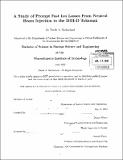A study of prompt fast ion losses from neutral beam injection in the DIII-D tokamak
Author(s)
Sutherland, Derek A. (Derek Aiden)
DownloadFull printable version (4.498Mb)
Other Contributors
Massachusetts Institute of Technology. Dept. of Nuclear Science and Engineering.
Advisor
Dennis Whyte.
Terms of use
Metadata
Show full item recordAbstract
A study of the prompt losses of injected neutral beam born fast ions was conducted on the DIII-D tokamak at General Atomics using scintillator based fast ion loss detectors (FILD) and a reverse orbit calculation code. Prompt losses, also called first orbit losses, result from injected neutrals that are ionized on orbits that terminate to the outer wall before making a complete neoclassical, poloidal revolution. A strike map code has been developed which generates meshes that overlay optical fast ion signals from the FILD scintillator, providing a measurement of the pitch angles and gyroradii of incident fast ions. The pitch angles and gyroradii of incident ions are inputs to a reverse orbit calculation code used to calculate the trajectories of the incident ions in reverse time back to their birth at the intersection of the reverse orbit and an overlaid neutral beam injection footprint. The megahertz (MHz) sampling frequency of the FILD scintillator, along with finer time resolution neutral beam signals, enabled a comparison of the measured time delay between the onset of the neutral beam injection and the measured FILD loss signals with the calculated transit time based on the path length of the simulated reverse orbit. Consistency between the experimentally measured transit times and the simulation orbit times was observed. This result indicates the generated strike maps which provide a measurement of incident ions' gyroradii and pitch angles are accurate. This study supplements current studies seeking to improve the understanding of fast ion transport due to magnetohydrodynamic (MHD) activity, such as reverse shear Alfven eigenmodes (RSAEs) and toroidal Alfven eigenmodes (TAEs), which will be of great importance for predominately self-heated reactor scenarios.
Description
Thesis (S.B.)--Massachusetts Institute of Technology, Dept. of Nuclear Science and Engineering, 2012. "June 2012." Cataloged from PDF version of thesis. Includes bibliographical references (p. 29).
Date issued
2012Department
Massachusetts Institute of Technology. Department of Nuclear Science and EngineeringPublisher
Massachusetts Institute of Technology
Keywords
Nuclear Science and Engineering.